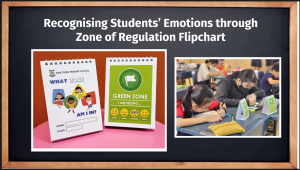Why Singapore’s English Teachers Should Embrace Singlish, Not Fight It
Is it time for Singaporean educators to embrace Singlish as a legitimate learning tool? What the Research […]
Read More
How can insights from neuroscience influence the way teachers teach and learners learn? At New Town Primary School, teachers have adopted teaching strategies and practices that are underpinned by brain-based principles. Two teachers from the school share with us their experiences in translating brain-based principles to classroom practices.

Mdm Woon Wei Li and Mdm Siti Mariam, together with their team of teachers from New Town Primary School, were first exposed to brain-based principles in 2021. “Our team attended two workshops organized by the Academy of Singapore Teachers (AST) on brain-based principles. This was where we learnt more about the key areas of brain-based principles such as neuroplasticity, emotions and memory, and how applying them into classroom practices can improve student learning outcomes,” Wei Li, Upper Primary Year Head, shares.
They were then inspired to share their learning experience with other teachers at their school. To get the teachers on board, Wei Li and her team stressed that the adoption of brain-friendly strategies in the classrooms are not new initiatives, but rather provide another lens with which teachers can use to reflect and improve on their own teaching practices.
“The teachers were eager to implement these initiatives after we took the time to emphasize how neuroscience findings can actually improve our understanding of each student profile and their learning needs,” she adds.
Neuroscience findings show that only 10% of the human brains can be classified as typical. Various factors such as age and gender make our brain unique, and the two most important factors that affect the brain are environment and gene expression, with environment playing a bigger role.
“While it is impossible to change our students’ age, genetics and other factors, we can work on shaping a positive environment for our learners. The fact that the brain continues to create new neural pathways or alter existing ones in order to adapt to new experiences also underscores the importance of a nurturing environment to learning,” Wei Li remarks.
One crucial factor in creating such an environment is positive teacher-student relationships as well as peer support and relationships. A way to develop such relationships is through a growth mindset, that is the belief that abilities can be developed and improved through effort.
“To nurture a growth mindset in students, teachers at New Town Primary have put in more effort to recognize each student’s strengths, affirm each student’s efforts in learning, encourage them to view mistakes as learning opportunities, and most importantly, role model the growth mindset,” she says.
Siti, Subject Head (Student Well-Being), notes how using positive teacher language in the classroom can help build trust between students and teachers as well as promote positive peer relationships. As part of efforts to build a class identity through a shared vision, New Town Primary has made it mandatory for every class to craft a classroom mission statement that they can refer to throughout the year.
“Co-creating the class mission statements means that the mission statements are unique and tailored to the profile and needs of each class,” she states.
She highlights how these classroom practices align with neuroscience research which shows students learn better when they feel socially connected to their teachers and peers in their learning environments. Furthermore, research has shown that being in a positive emotional state allows for deeper learning during lessons.
“While it is impossible to change our students’ age, genetics and other factors, we can work on shaping a positive environment for our learners. The fact that the brain continues to create new neural pathways or alter existing ones in order to adapt to new experiences also underscores the importance of a nurturing environment to learning.”
– Wei Li, on the importance of a nurturing environment to learning
How does the brain work when it comes to learning? First, we need to know what occurs during the cognitive learning process.
“The cognitive learning process consists of four stages–attention, encoding, storage and retrieval,” Siti explains. “Every day we are exposed to millions of bits of sensory data. However, findings from neuroscience research show that only about 1% of sensory data can get through the brain’s filter each second. The brain constantly processes sensory data, but our attention selects only a small fraction of it for conscious thought. So, how can we ensure that our students are even paying attention in the first place?”
She says that an effective way to capture their attention is to introduce something unexpected during the lesson which can take the form of sounds, colour and/or movement. This is aligned to research showing that the brain seeks novelty and pattern.
New Town Primary has also adopted the “All Learners Learning Every Day (ALL-ED)” framework which is based on differentiated instruction. This framework, she explains, supports teachers in restoring the students’ attention based on teacher observations and the learning needs of each child.
“Teachers are encouraged to move around the classroom, so that they are able to observe what the students are doing or struggling with, and then to respond promptly to the students’ needs.”
The amygdala is the major processing centre for emotions, emotional behaviour and motivation. When the amygdala senses dopamine, which is a feel-good hormone, the brain becomes thinking and reflective. However, when the amygdala senses threat, it becomes over activated and new information cannot pass through the brain to allow learning to be processed or stored.
“How can we apply this principle to support students who are in emotional distress?” Wei Li asks. “First, we should acknowledge the emotions of the child; only when their feelings are recognized and regulation skills are applied, will the child be able to follow other instructions.”
She describes how the school has provided each student with a “Zones of Regulation Flipchart” (see Figure 1).

Figure 1. The Zones of Regulation Flipchart.
“The flipchart, which comes with different coloured zones to indicate different emotions, allows each student to be in touch with their emotions and express how they are feeling by selecting one of the coloured zones. This way, teachers can identify the well-being and emotions of each child and provide timely intervention and support,” she says.
To further support students in managing their feelings and behaviour, the school has also set up a calm down corner in every classroom. It is designed as a safe space that allows the students to take a mental break when feeling overwhelmed and to regulate themselves before joining the lesson.
“The calm down corner is equipped with items such as a timer, fidget toys and stress balls,” she notes. “Students can also ask for a timeout whenever they need one.”
Wei Li and Siti are heartened to receive good feedback from teachers. “Our colleagues have said that the classroom and teaching strategies they have implemented have helped improved learning experiences for students. We hope in the long run this will lead to increased knowledge retention and improved academic performance among students,” Wei Li says.
She adds that New Town Primary has embarked on a tripartite effort to equip their students and parents with knowledge about brain-based principles. “We want to share this knowledge with the students and parents as we recognize the importance of home-school partnership. The support from parents in helping children learn better is invaluable,” she concludes.